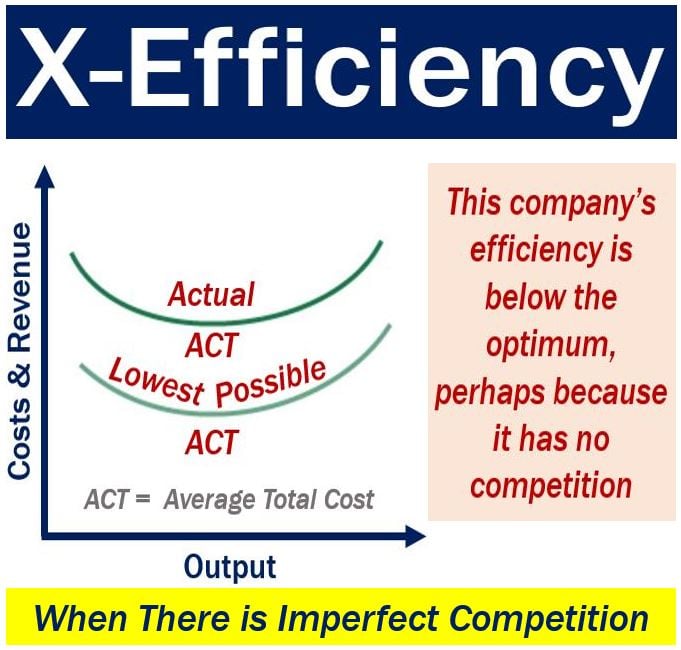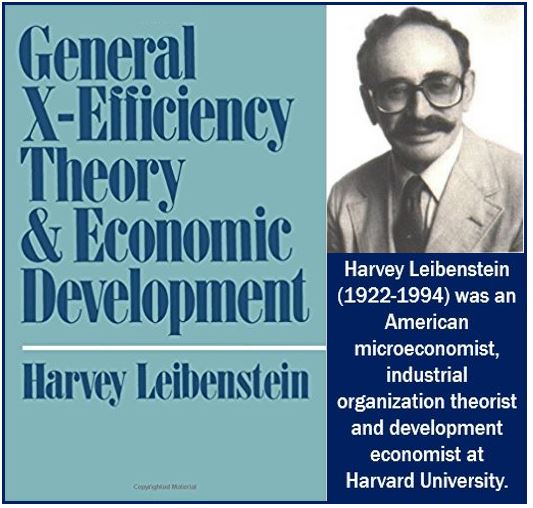X-Efficiency – definition and meaning
X-efficiency and X-inefficiency refer to the ability or inability of a business to achieve maximum output for its inputs. The ‘inability’ is due to a lack of competition in the market, or a lack of desire to compete aggressively. When commercial enterprises are not very competitive, as may occur in a monopoly, duopoly, or a market without many competitors, many of the workers and members of senior management tend not to behave as efficiently.
Put simply, X-efficiency is the degree of efficiency that companies and people under conditions of imperfect competition maintain.
In a market where lots of competition exists – where there is **perfect competition – companies are encouraged to seek productive efficiency gains and produce at lowest unit costs, otherwise they will probably lose sales to more efficient competitors.
** Perfect competition is a theoretical free-market Utopia where there are many purchasers and sellers – none of them has a significant impact on the prices of goods and services.
 The X-efficiency concept is used to gauge or compare the levels of motivation of management and the workers in different companies regarding maximizing output. X-inefficiency is a company’s failure to produce any specific output at the lowest possible ATC (average total cost). (Image: adapted from economicsonline.co.uk)
The X-efficiency concept is used to gauge or compare the levels of motivation of management and the workers in different companies regarding maximizing output. X-inefficiency is a company’s failure to produce any specific output at the lowest possible ATC (average total cost). (Image: adapted from economicsonline.co.uk)
Where there is **imperfect competition – as occurs in a monopoly or duopoly – productive inefficiency may persist, because the lone producer can still thrive with inefficient production techniques.
** Imperfect competition is a market where barriers to entry exist. These barriers prevent a state of perfect competition from existing.
Apart of a monopoly, sociologists have identified several ways in which X-efficiency persists – where markets depart in behavior from economic theory.
X-efficiency and Harvey Leibenstein
The term X-efficiency was first used by Harvey Leibenstein (1922-1994), a Ukrainian-born American economist. Leibenstein, a Harvard professor, studied the psychological aspects of economics. He first used the term in a 1966 paper – Allocative Efficiency vs. ‘X-Efficiency’, published by The American Economic Review, Volume 56, Issue 3.
According to Leibenstein’s theory, when commercial enterprises are not competitive, their workforces do not behave as efficiently.
Imagine that John Doe Inc., Mary Smith Corp., and CRadios Co. together have 90% of the market for car radios in one country. They are huge companies that compete aggressively on price, as well as service.
 According to hetwebsite.net: “Harvey Leibenstein is most famous for introducing the “x-efficiency” concept (1966), roughly a catch-all term for the notion that ideal technical efficiency is frustrated in reality by people and organizations, due to a variety of factors, such as institutional frictions, missing markets and lack of information. Leibenstein is now often hailed as a pioneer of behavioral economics. (Book Image: Amazon)
According to hetwebsite.net: “Harvey Leibenstein is most famous for introducing the “x-efficiency” concept (1966), roughly a catch-all term for the notion that ideal technical efficiency is frustrated in reality by people and organizations, due to a variety of factors, such as institutional frictions, missing markets and lack of information. Leibenstein is now often hailed as a pioneer of behavioral economics. (Book Image: Amazon)
Fred Bloggs Radios is a very small company that is trying to break into the car radio market – it is desperately attempting to gain larger market share. However, Fred Bloggs is not operating profitably.
Even though the market for car radios is fiercely competitive, Fred Bloggs is not much of a competitor, and its workers are aware of this. According Leibenstein’s theory, the workers at Fred Bloggs do not work as hard as those in the other companies because of this.
Bloggs’ workers know that no matter how hard they try, they will never get anywhere near the efficiency or productivity levels of the other three giant competitors – i.e. their X-efficiency declines.
Similarly, let’s imagine that John Doe Inc. has a total monopoly of the car radio market – it is the only manufacturer in the country. According to the theory, under this scenario, John Doe’s workers’ X-efficiency will also fall – they will become less productive because they know that nothing foreseeable will alter their employer’s dominant position in the market.
X-efficiency vs. neoclassical economists
Prof. Leibenstein’s X-efficiency concept clashes with the theories of traditional neoclassical economists. Neoclassical economists believe that companies, entrepreneurs, and their workers always maximize utility.
The concept of X-efficiency suggests that we do not always maximize utility – we do not always choose the most efficient option.
In his 1966 paper, Leibenstein wrote:
“For a variety of reasons, people and organizations normally work neither as hard nor as effectively as they could. In situations where competitive pressure is light, many people will trade the disutility of greater effort, of search, and the control of other people’s activities for the utility of feeling less pressure and of better interpersonal relations.”
“But in situations where competitive pressures are high, and hence the costs of such trades are also high, they will exchange less of the disutility of effort for the utility of freedom and from pressure, etc.”
“Two general types of movements are possible. One is along a production surface toward greater allocative efficiency, and the other is from a lower surface to a higher one that involves greater degrees of X-efficiency.”
Video – The Efficiency Paradox
In this Tedx Talks video, Niklas Modig, an inspirational speaker, researcher and author, talks about the term ‘efficiency’. It is a term we all use, but very few of us fully understand.
He argues that 98% of all organizations do not really understand what ‘true efficiency’ really is. We have the tendency to focus too much on individual and functional performance.

